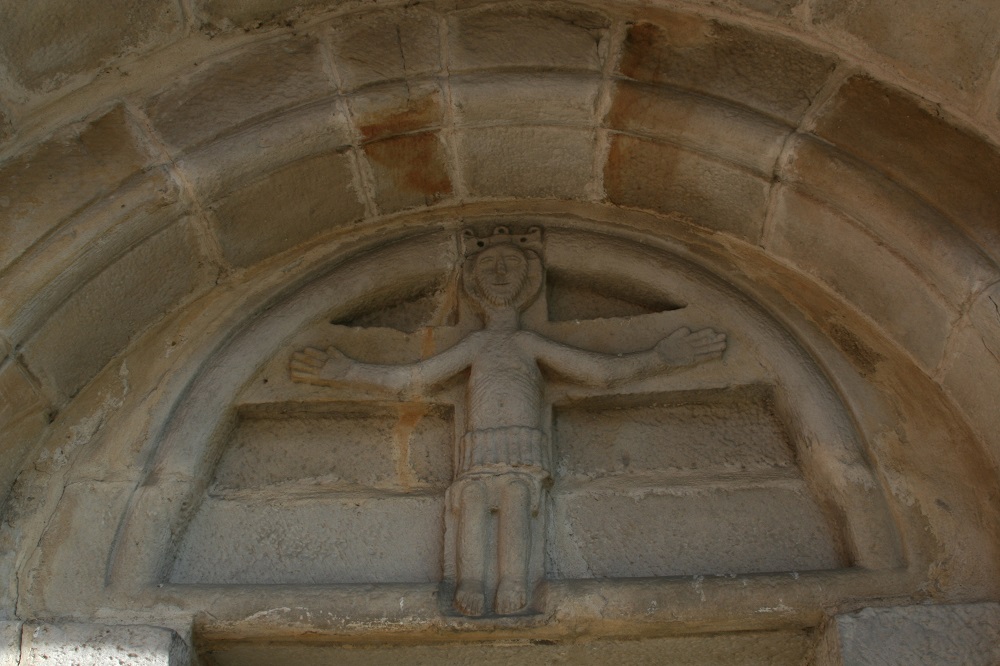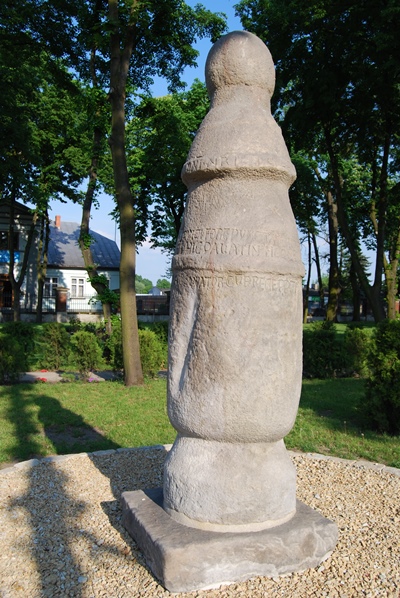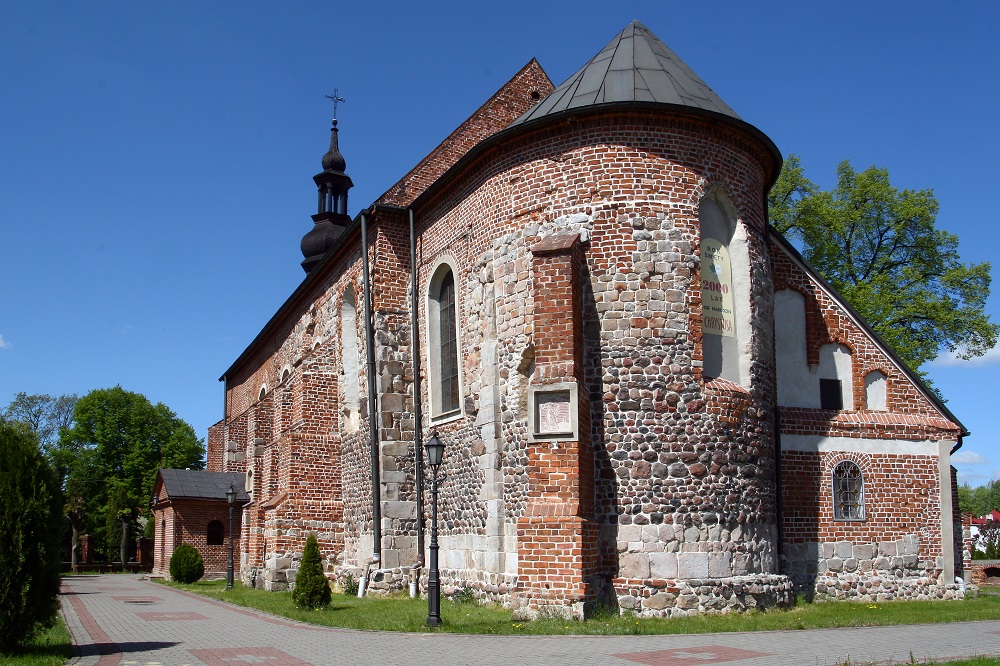Kalisz – Kościelec Kaliski – Dzierzbin – Stare Miasto – Konin – Kazimierz Biskupi – Strzelno – Kruszwica
Despite the fact that during the 11th to 13th centuries the Konin district was somewhat distant from the power centers of Wielkopolska, it preserved numerous unique examples of Romanesque architecture and art that cannot be found elsewhere in the province, the country, or even Europe. Visiting these sites significantly enriches the experience of exploring the most important and widely known Piast Trail. These sites include, above all, sacred Romanesque buildings in Stare Miasto near Konin, Kazimierz Biskupi, Kościelec near Koło, and the Konin road post—an object unique on a European scale. Additionally, two penitential crosses, one in Konin and one in Licheń, have been preserved.
Fragments of the historical landscape, with a few preserved Romanesque objects and other structures from the 11th to 13th centuries, most impressively illustrate the beginnings of Polish statehood and culture. They mark the early medieval trail leading from Kalisz, through Konin, to Kruszwica, which is mentioned in a note on the Konin road post dated 1151. This post was erected by Peter, the Palatine.
Kalisz-Zawodzie
From Kalisz-Zawodzie, a former trade settlement (the so-called town under Polish law), we follow a trail that takes us back as far as the mid-12th century. In this city, ruled by Prince Mieszko III, there once stood the collegiate church of St. Paul the Apostle. According to Jan Długosz (died 1480), the body of Mieszko, the prince of Wielkopolska and son of King Bolesław Krzywousty (Boleslaus the Wry-mouthed, died 1202), was laid here.
Kościelec Kaliski
Kościelec Kaliski is the first stop on our journey. This village was the site of a provostry of the Benedictine monastery from Tyniec, which had strong connections with the convents of the Benedictine Order in Lubiń near Kościan, Mogilno near Gniezno, and Uniejów.
Stare Miasto
Stare Miasto is an ancient trade  settlement (town under Polish law) that developed into the city of Konin, which was granted Magdeburg law in the mid-13th century. For many years, before the construction of the royal castle in the 14th century, it served as the residence of local princes, and later, non-city prefects who managed one of the wealthiest crown lands in Wielkopolska.
settlement (town under Polish law) that developed into the city of Konin, which was granted Magdeburg law in the mid-13th century. For many years, before the construction of the royal castle in the 14th century, it served as the residence of local princes, and later, non-city prefects who managed one of the wealthiest crown lands in Wielkopolska.
The St. Peter and Paul parish church, for many years referred to as the mother church of the St. Bartholomew the Apostle parish in Konin, is a relic connected to the history of Konin. It was built at the end of the 12th century or the beginning of the 13th century. The first written mention of the church dates back to the mid-14th century.
During renovations in 1907, an empora (the area where kings sat during religious celebrations) and two towers were destroyed. As a result, the Romanesque church was incorporated as a chapel into the current building, losing much of its original character.
Fortunately, some relics of the church have survived, including the magnificent Romanesque portal decorated with symbolic representations of various figures and Christ. Above the southern window near thepresbytery, one can still see signs of a sundial, likely one of the oldest in Wielkopolska. The walls of the new church contain a Romanesque tombstone with the symbol of the Tree of Life. Similar but smaller tombstones have been preserved in the parish church in Królików (Konin district, Grodziec municipality). They are also linked to the relics of St. Paul’s collegiate church in Kalisz.
Konin
The next stop on the Romanesque Trail is Konin. Near the St. Bartholomew Church, a Romanesque road post dating back to 1151 has been preserved. It was erected here by Peter, the Palatine, and marks the halfway point of an important trade route leading from Kalisz to Kruszwica. It is commonly believed that the post was originally a pagan cult object.
The inscription on the post reads (translated into English):
In the year 1151, the year of Our Lord’s incarnation,
on the Kalisz-Kruszwica route, here at almost the midpoint of the road,
marked by the formula of justice,
which was ordered to be made here by Peter, the Palatine,
and carefully divided the road in half,
to be remembered, and let each traveler
ask God for grace.
This nobleman, the palatine (court official), is likely Peter Wszeborowic, a dignitary associated with the Kujawy region during the reign of Mieszko II the Old, prince of Wielkopolska. His involvement is confirmed by a historical register related to the city of Konin, which is older than the one cited in historiography. The location of the road post suggests that Konin must have already played an important role in cross-border trade routes.
Kazimierz Biskupi
From Konin, we travel to Kazimierz Biskupi, a former town associated with the bishops of Lublin, founded in the second half of the 13th century. Tradition links this place to the death of the Five Martyr Brothers, who were murdered on the night of November 10–11, 1003. The brothers included two barons, John and Benedict, disciples of St. Romuald from the monastery in Pereum, located in the Pad Backwaters, as well as three Slavs—Isaac, Matthew, and Cristin, their servant. The cult of the first Polish saints (Isaac, Matthew, and Cristin) was known here as early as the mid-12th century, and it may even date back to the late 12th century, as suggested by preserved sources. Due to the significant devotion of worshipers, it continues to this day. The town of Kazimierz, known as Kazimierz Biskupi since the 20th century, became an important sanctuary in Wielkopolska in the early 14th century. Thecult influenced surrounding areas such as Strzelno, Trzemeszno, Gniezno, Września, Słupca, Ląd, and Jarocin. The Franciscan Observants, who arrived here in the early 16th century, and the Camaldolese monks from Bieniszew (1663), actively promoted the cult throughout Poland. These monks maintained long-lasting relationships with other monastic houses, a connection that endures to this day.
The parish church of St. Martin of To urs, once part of the patrimony of St. Martin and the Five Martyr Brothers, was erected on the site of Brother Matthew’s hermitage, according to Jan Długosz (died 1480). It is a valuable example of Romanesque architecture.
urs, once part of the patrimony of St. Martin and the Five Martyr Brothers, was erected on the site of Brother Matthew’s hermitage, according to Jan Długosz (died 1480). It is a valuable example of Romanesque architecture.
The sanctuary in Kazimierz reflects its turbulent past, visible not only in the architectural elements (such as the portal), but also in the numerous marks and traces of development from the early 16th century to the mid-19th century. This history is recorded in the brickwork, the size of the bricks, the manner of laying Romanesque stones in the presbytery, as well as signs of weapon sharpening and the so-called "penance holes" left by the kindling and consecration fires. These mysterious signs have inspired many local legends, the oldest of which relate to the arrival of Italian hermits in Poland in the early 11th century and their connections to the Camaldolese monks from Monte Orone in Italy.
Unique to Poland are the two penitential crosses. One is embedded in the brick wall of St. Bartholomew’s Church in Konin, while the other was moved to the chapel in Licheń from Grąblin, though the process of sanding it destroyed the cross. Penitential crosses are symbols of atonement for people who have committed crimes, serving as a means to seek eternal remission for their sins.
Centuries-old connections between thesetowns in the Konin district, and the monasteries in Trzemeszno, Strzelno, the collegiate church in Kruszwica, Kalisz, and the cathedrals in Gniezno and Poznań, enrich our knowledge of early Polish history. The roads leading to Strzelno, Kruszwica, Poznań, and Gniezno, which cross the Konin district, provide an excellent opportunity to visit these places, deepening our understanding of the cultural heritage of the Piast Trail.
Jerzy Łojko






